Audit, Assurance, and Compliance - Individual Assignment 1 Solution
VerifiedAdded on 2020/03/07
|10
|2357
|106
Homework Assignment
AI Summary
This assignment solution focuses on an audit, assurance, and compliance individual assignment. It begins with an overview of analytical procedures, their purposes (preliminary, substantive, and final reviews), and their application in risk assessment and fraud detection within financial statements. The solution then delves into the importance of internal control systems and their impact on audit scope. It identifies key areas for detailed examination, including inventory, ebook storage fees, bad debts, cash, employee payments, and revenue from ebooks. The document also examines inherent risks, such as those related to inventory recording and cash receipts, and discusses factors that could lead to fraud, including the acquisition of Nuclear Publishing Ltd and inventory management challenges. Finally, it addresses how auditors should adapt their approach based on the identified risks and the strength of internal controls, and how to deal with the possibility of fraud, including the framing of audit opinions.

Audit, Assurance, and Compliance
INDIVIDUAL ASSIGNMENT 1
1 | P a g e
INDIVIDUAL ASSIGNMENT 1
1 | P a g e
Paraphrase This Document
Need a fresh take? Get an instant paraphrase of this document with our AI Paraphraser
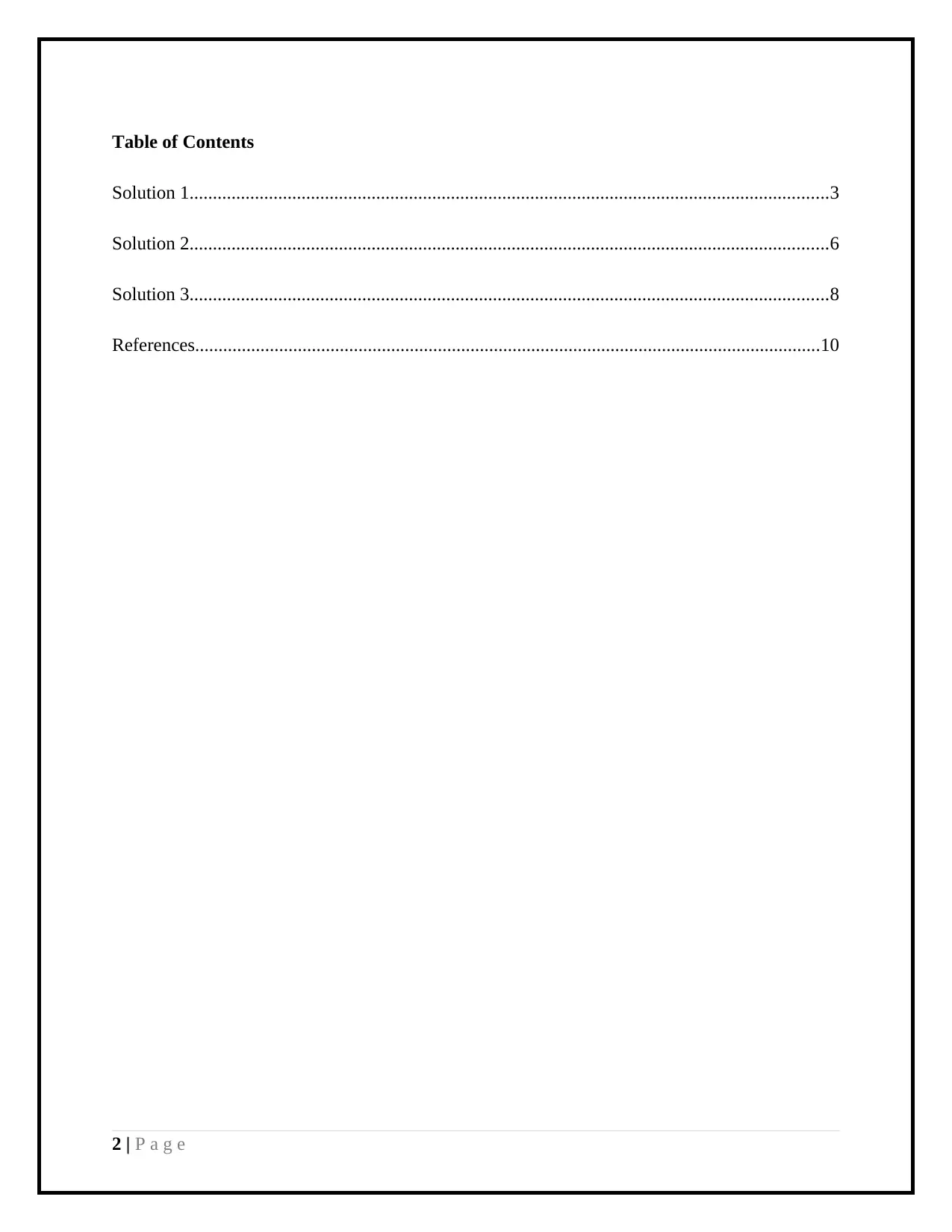
Table of Contents
Solution 1.........................................................................................................................................3
Solution 2.........................................................................................................................................6
Solution 3.........................................................................................................................................8
References......................................................................................................................................10
2 | P a g e
Solution 1.........................................................................................................................................3
Solution 2.........................................................................................................................................6
Solution 3.........................................................................................................................................8
References......................................................................................................................................10
2 | P a g e
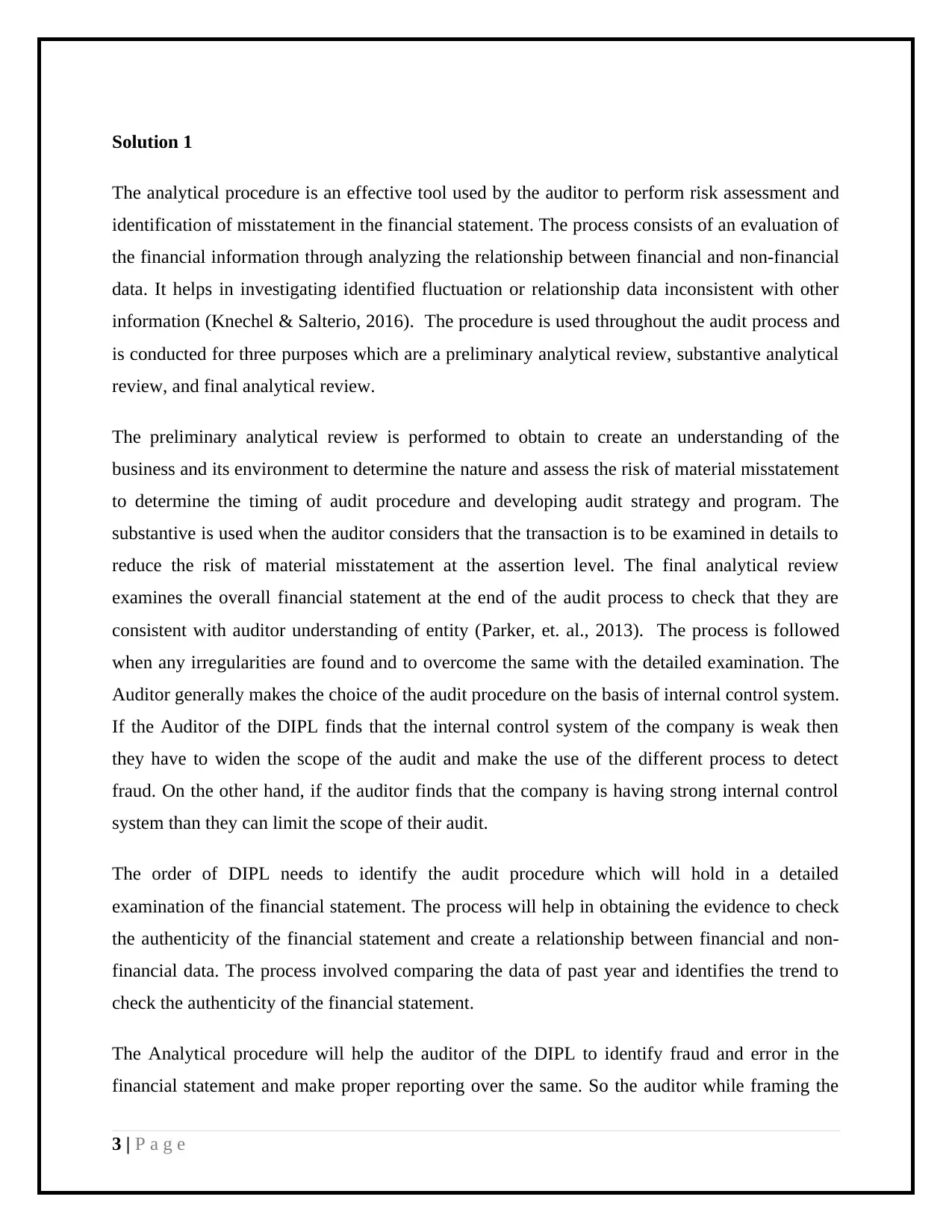
Solution 1
The analytical procedure is an effective tool used by the auditor to perform risk assessment and
identification of misstatement in the financial statement. The process consists of an evaluation of
the financial information through analyzing the relationship between financial and non-financial
data. It helps in investigating identified fluctuation or relationship data inconsistent with other
information (Knechel & Salterio, 2016). The procedure is used throughout the audit process and
is conducted for three purposes which are a preliminary analytical review, substantive analytical
review, and final analytical review.
The preliminary analytical review is performed to obtain to create an understanding of the
business and its environment to determine the nature and assess the risk of material misstatement
to determine the timing of audit procedure and developing audit strategy and program. The
substantive is used when the auditor considers that the transaction is to be examined in details to
reduce the risk of material misstatement at the assertion level. The final analytical review
examines the overall financial statement at the end of the audit process to check that they are
consistent with auditor understanding of entity (Parker, et. al., 2013). The process is followed
when any irregularities are found and to overcome the same with the detailed examination. The
Auditor generally makes the choice of the audit procedure on the basis of internal control system.
If the Auditor of the DIPL finds that the internal control system of the company is weak then
they have to widen the scope of the audit and make the use of the different process to detect
fraud. On the other hand, if the auditor finds that the company is having strong internal control
system than they can limit the scope of their audit.
The order of DIPL needs to identify the audit procedure which will hold in a detailed
examination of the financial statement. The process will help in obtaining the evidence to check
the authenticity of the financial statement and create a relationship between financial and non-
financial data. The process involved comparing the data of past year and identifies the trend to
check the authenticity of the financial statement.
The Analytical procedure will help the auditor of the DIPL to identify fraud and error in the
financial statement and make proper reporting over the same. So the auditor while framing the
3 | P a g e
The analytical procedure is an effective tool used by the auditor to perform risk assessment and
identification of misstatement in the financial statement. The process consists of an evaluation of
the financial information through analyzing the relationship between financial and non-financial
data. It helps in investigating identified fluctuation or relationship data inconsistent with other
information (Knechel & Salterio, 2016). The procedure is used throughout the audit process and
is conducted for three purposes which are a preliminary analytical review, substantive analytical
review, and final analytical review.
The preliminary analytical review is performed to obtain to create an understanding of the
business and its environment to determine the nature and assess the risk of material misstatement
to determine the timing of audit procedure and developing audit strategy and program. The
substantive is used when the auditor considers that the transaction is to be examined in details to
reduce the risk of material misstatement at the assertion level. The final analytical review
examines the overall financial statement at the end of the audit process to check that they are
consistent with auditor understanding of entity (Parker, et. al., 2013). The process is followed
when any irregularities are found and to overcome the same with the detailed examination. The
Auditor generally makes the choice of the audit procedure on the basis of internal control system.
If the Auditor of the DIPL finds that the internal control system of the company is weak then
they have to widen the scope of the audit and make the use of the different process to detect
fraud. On the other hand, if the auditor finds that the company is having strong internal control
system than they can limit the scope of their audit.
The order of DIPL needs to identify the audit procedure which will hold in a detailed
examination of the financial statement. The process will help in obtaining the evidence to check
the authenticity of the financial statement and create a relationship between financial and non-
financial data. The process involved comparing the data of past year and identifies the trend to
check the authenticity of the financial statement.
The Analytical procedure will help the auditor of the DIPL to identify fraud and error in the
financial statement and make proper reporting over the same. So the auditor while framing the
3 | P a g e
⊘ This is a preview!⊘
Do you want full access?
Subscribe today to unlock all pages.

Trusted by 1+ million students worldwide
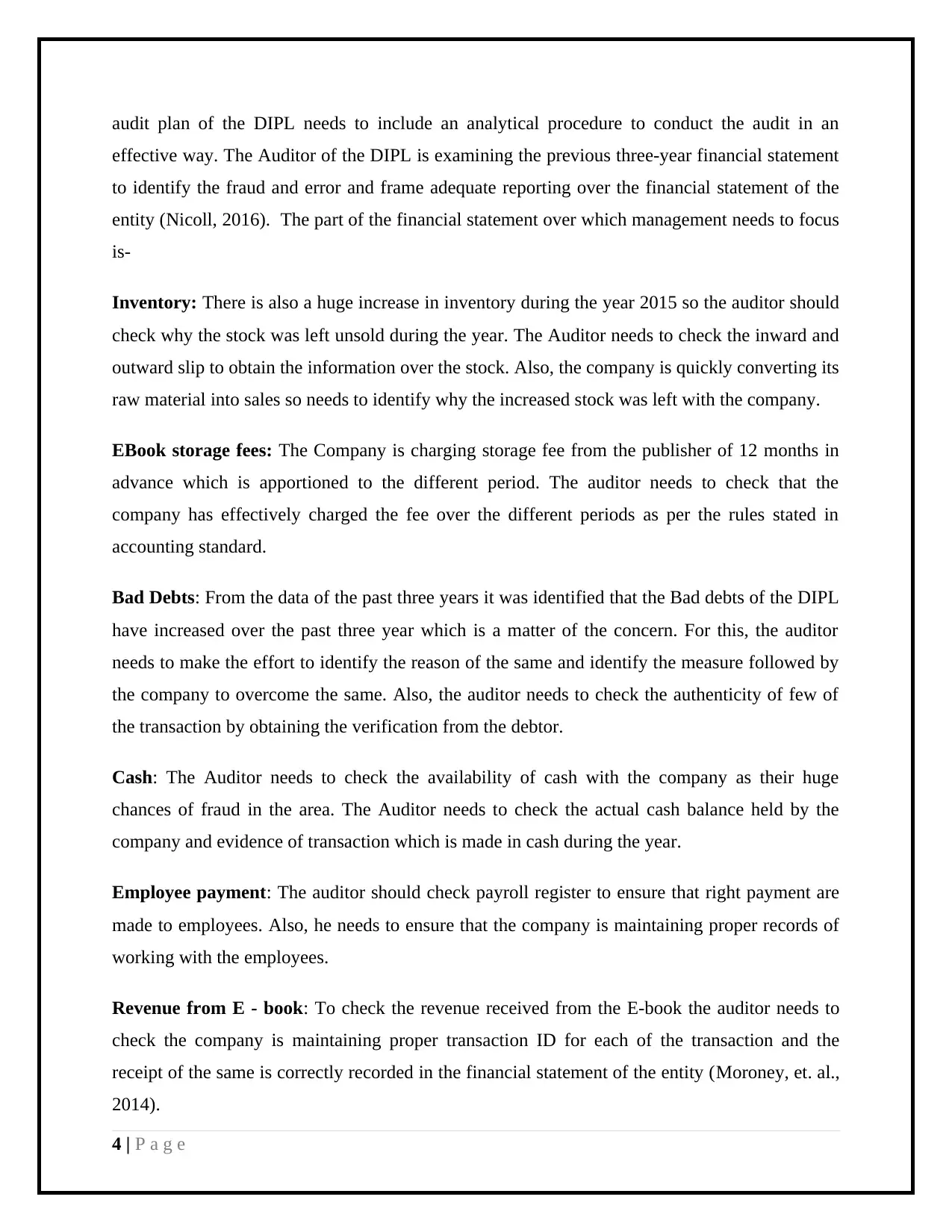
audit plan of the DIPL needs to include an analytical procedure to conduct the audit in an
effective way. The Auditor of the DIPL is examining the previous three-year financial statement
to identify the fraud and error and frame adequate reporting over the financial statement of the
entity (Nicoll, 2016). The part of the financial statement over which management needs to focus
is-
Inventory: There is also a huge increase in inventory during the year 2015 so the auditor should
check why the stock was left unsold during the year. The Auditor needs to check the inward and
outward slip to obtain the information over the stock. Also, the company is quickly converting its
raw material into sales so needs to identify why the increased stock was left with the company.
EBook storage fees: The Company is charging storage fee from the publisher of 12 months in
advance which is apportioned to the different period. The auditor needs to check that the
company has effectively charged the fee over the different periods as per the rules stated in
accounting standard.
Bad Debts: From the data of the past three years it was identified that the Bad debts of the DIPL
have increased over the past three year which is a matter of the concern. For this, the auditor
needs to make the effort to identify the reason of the same and identify the measure followed by
the company to overcome the same. Also, the auditor needs to check the authenticity of few of
the transaction by obtaining the verification from the debtor.
Cash: The Auditor needs to check the availability of cash with the company as their huge
chances of fraud in the area. The Auditor needs to check the actual cash balance held by the
company and evidence of transaction which is made in cash during the year.
Employee payment: The auditor should check payroll register to ensure that right payment are
made to employees. Also, he needs to ensure that the company is maintaining proper records of
working with the employees.
Revenue from E - book: To check the revenue received from the E-book the auditor needs to
check the company is maintaining proper transaction ID for each of the transaction and the
receipt of the same is correctly recorded in the financial statement of the entity (Moroney, et. al.,
2014).
4 | P a g e
effective way. The Auditor of the DIPL is examining the previous three-year financial statement
to identify the fraud and error and frame adequate reporting over the financial statement of the
entity (Nicoll, 2016). The part of the financial statement over which management needs to focus
is-
Inventory: There is also a huge increase in inventory during the year 2015 so the auditor should
check why the stock was left unsold during the year. The Auditor needs to check the inward and
outward slip to obtain the information over the stock. Also, the company is quickly converting its
raw material into sales so needs to identify why the increased stock was left with the company.
EBook storage fees: The Company is charging storage fee from the publisher of 12 months in
advance which is apportioned to the different period. The auditor needs to check that the
company has effectively charged the fee over the different periods as per the rules stated in
accounting standard.
Bad Debts: From the data of the past three years it was identified that the Bad debts of the DIPL
have increased over the past three year which is a matter of the concern. For this, the auditor
needs to make the effort to identify the reason of the same and identify the measure followed by
the company to overcome the same. Also, the auditor needs to check the authenticity of few of
the transaction by obtaining the verification from the debtor.
Cash: The Auditor needs to check the availability of cash with the company as their huge
chances of fraud in the area. The Auditor needs to check the actual cash balance held by the
company and evidence of transaction which is made in cash during the year.
Employee payment: The auditor should check payroll register to ensure that right payment are
made to employees. Also, he needs to ensure that the company is maintaining proper records of
working with the employees.
Revenue from E - book: To check the revenue received from the E-book the auditor needs to
check the company is maintaining proper transaction ID for each of the transaction and the
receipt of the same is correctly recorded in the financial statement of the entity (Moroney, et. al.,
2014).
4 | P a g e
Paraphrase This Document
Need a fresh take? Get an instant paraphrase of this document with our AI Paraphraser
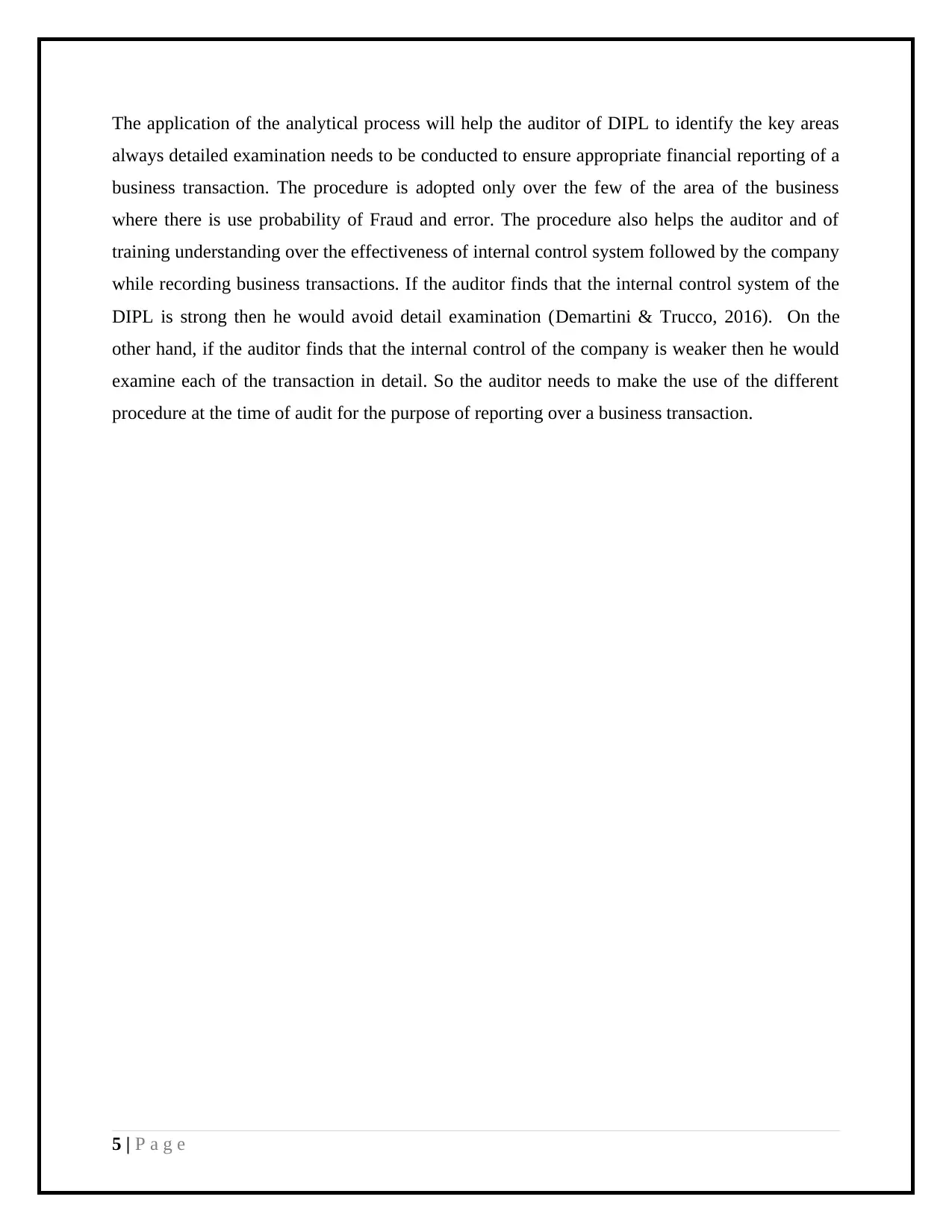
The application of the analytical process will help the auditor of DIPL to identify the key areas
always detailed examination needs to be conducted to ensure appropriate financial reporting of a
business transaction. The procedure is adopted only over the few of the area of the business
where there is use probability of Fraud and error. The procedure also helps the auditor and of
training understanding over the effectiveness of internal control system followed by the company
while recording business transactions. If the auditor finds that the internal control system of the
DIPL is strong then he would avoid detail examination (Demartini & Trucco, 2016). On the
other hand, if the auditor finds that the internal control of the company is weaker then he would
examine each of the transaction in detail. So the auditor needs to make the use of the different
procedure at the time of audit for the purpose of reporting over a business transaction.
5 | P a g e
always detailed examination needs to be conducted to ensure appropriate financial reporting of a
business transaction. The procedure is adopted only over the few of the area of the business
where there is use probability of Fraud and error. The procedure also helps the auditor and of
training understanding over the effectiveness of internal control system followed by the company
while recording business transactions. If the auditor finds that the internal control system of the
DIPL is strong then he would avoid detail examination (Demartini & Trucco, 2016). On the
other hand, if the auditor finds that the internal control of the company is weaker then he would
examine each of the transaction in detail. So the auditor needs to make the use of the different
procedure at the time of audit for the purpose of reporting over a business transaction.
5 | P a g e

Solution 2
The auditor at the time of the creating the audit plan should consider the way he would examine
all the risk which will create impact over his reporting over the financial transaction. The auditor
needs to have the check over the inherent risk which may arise in spite of the stronger internal
control system. The inherent risk is the risk of the material misstatement in the financial
statement which may arise due to error or omission. The Inherent risk is higher in the situation
where there is a high degree of judgment or estimate or a lot of complexity involved in the
business transaction. For identifying the inherent risk the auditor needs to examine the
transaction which is rapidly changing. Also, he needs to examine the misstatement in the
previous year transaction to avoid the similar mistake again (Lessambo, 2016). The risk
generally occurs due to the omission of recoding business transaction due to the complexity
involved in the process. The Two inherent risks which may occur at the DIPL are as follows-
Recording Inventory – The auditor of the DIPL needs to conduct the detail examination of the
way inventory is managed by the company as in spite of strong internal control system there is
the huge probability of error. The company is acquiring the resources from Australia and Asia
which creates complexity and may lead to the error at the time of recording the financial
transaction. Also, the company is maintaining an allowance for the obsolesce inventory. The
company if fails to make the right estimate in the area than it will create impact over the
reporting of the business transaction. During the year end, the company closes the warehouse
from 28 to 30 June for the purpose of stocktaking and invoices the sales on June 27. This may
lead to the stock left unsold and in transit which may create impact over the reporting of the
financial statement and can also lead to error (Chong, 2015). So the auditor needs to effectively
examine the transaction which has occurred around June 27 to avoid the occurrence of the fraud.
Cash receipt – The other area in the DIPL where there may be the possibility of the inherent risk
is on the recording of the cash receipt made by the company. The DIPL is receiving some of the
payment by cheque through mails where the cashier Judy Bones records the transaction in the
inward remittance and then bank the cheque and advice about the payment to the Gay Chan for
posting the same in the accounts receivables. There may be a possibility that the Judy Bones fails
to report the transaction as she has sole control over the mail which may lead to error in the
6 | P a g e
The auditor at the time of the creating the audit plan should consider the way he would examine
all the risk which will create impact over his reporting over the financial transaction. The auditor
needs to have the check over the inherent risk which may arise in spite of the stronger internal
control system. The inherent risk is the risk of the material misstatement in the financial
statement which may arise due to error or omission. The Inherent risk is higher in the situation
where there is a high degree of judgment or estimate or a lot of complexity involved in the
business transaction. For identifying the inherent risk the auditor needs to examine the
transaction which is rapidly changing. Also, he needs to examine the misstatement in the
previous year transaction to avoid the similar mistake again (Lessambo, 2016). The risk
generally occurs due to the omission of recoding business transaction due to the complexity
involved in the process. The Two inherent risks which may occur at the DIPL are as follows-
Recording Inventory – The auditor of the DIPL needs to conduct the detail examination of the
way inventory is managed by the company as in spite of strong internal control system there is
the huge probability of error. The company is acquiring the resources from Australia and Asia
which creates complexity and may lead to the error at the time of recording the financial
transaction. Also, the company is maintaining an allowance for the obsolesce inventory. The
company if fails to make the right estimate in the area than it will create impact over the
reporting of the business transaction. During the year end, the company closes the warehouse
from 28 to 30 June for the purpose of stocktaking and invoices the sales on June 27. This may
lead to the stock left unsold and in transit which may create impact over the reporting of the
financial statement and can also lead to error (Chong, 2015). So the auditor needs to effectively
examine the transaction which has occurred around June 27 to avoid the occurrence of the fraud.
Cash receipt – The other area in the DIPL where there may be the possibility of the inherent risk
is on the recording of the cash receipt made by the company. The DIPL is receiving some of the
payment by cheque through mails where the cashier Judy Bones records the transaction in the
inward remittance and then bank the cheque and advice about the payment to the Gay Chan for
posting the same in the accounts receivables. There may be a possibility that the Judy Bones fails
to report the transaction as she has sole control over the mail which may lead to error in the
6 | P a g e
⊘ This is a preview!⊘
Do you want full access?
Subscribe today to unlock all pages.

Trusted by 1+ million students worldwide

reporting of the financial transaction. As there is a lot of complexity involved in the process of
receiving payment from the email so the situation may cause inherent risk. The auditor needs to
examine the certain transaction which is received by emails to check that they are adequately
reported and recorded by Judy Bones.
7 | P a g e
receiving payment from the email so the situation may cause inherent risk. The auditor needs to
examine the certain transaction which is received by emails to check that they are adequately
reported and recorded by Judy Bones.
7 | P a g e
Paraphrase This Document
Need a fresh take? Get an instant paraphrase of this document with our AI Paraphraser
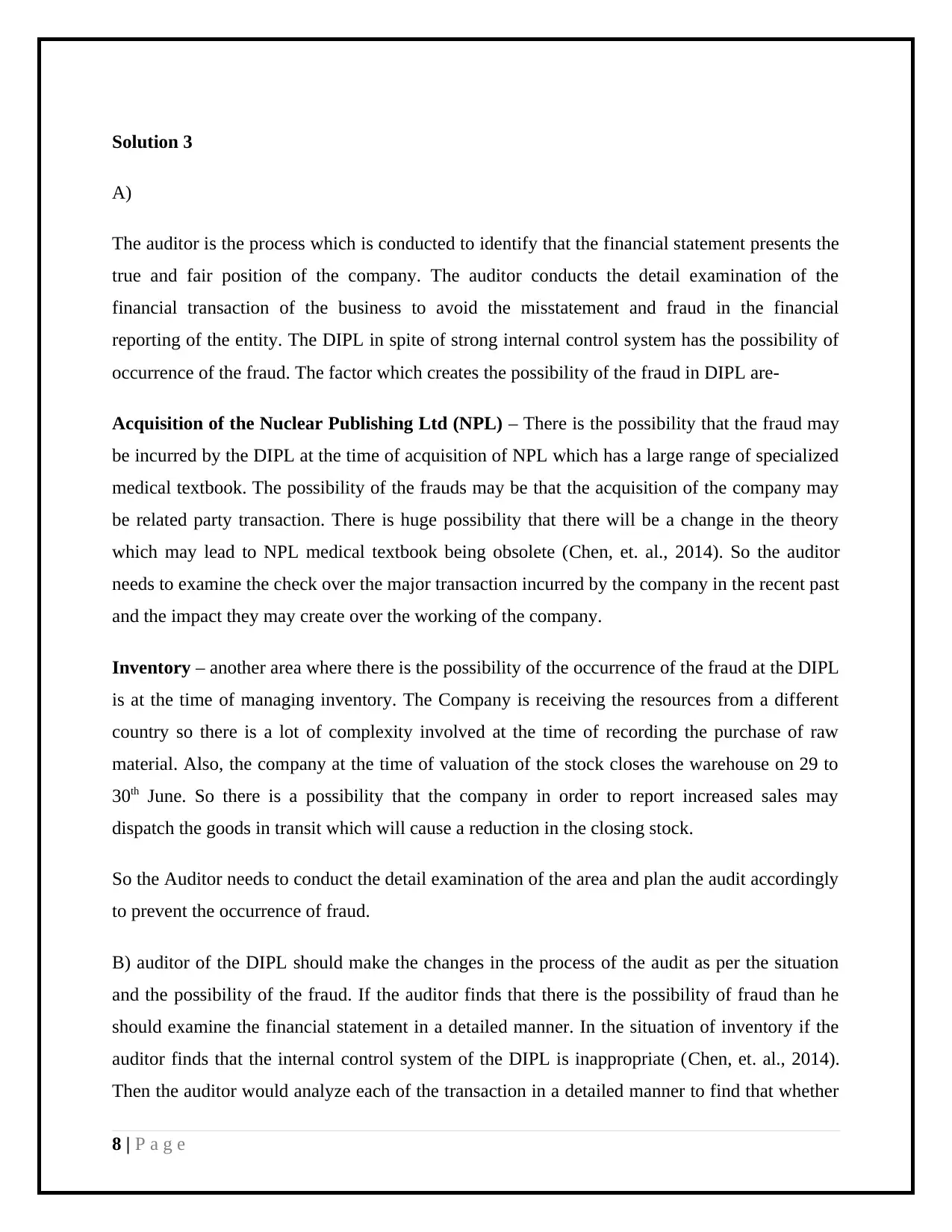
Solution 3
A)
The auditor is the process which is conducted to identify that the financial statement presents the
true and fair position of the company. The auditor conducts the detail examination of the
financial transaction of the business to avoid the misstatement and fraud in the financial
reporting of the entity. The DIPL in spite of strong internal control system has the possibility of
occurrence of the fraud. The factor which creates the possibility of the fraud in DIPL are-
Acquisition of the Nuclear Publishing Ltd (NPL) – There is the possibility that the fraud may
be incurred by the DIPL at the time of acquisition of NPL which has a large range of specialized
medical textbook. The possibility of the frauds may be that the acquisition of the company may
be related party transaction. There is huge possibility that there will be a change in the theory
which may lead to NPL medical textbook being obsolete (Chen, et. al., 2014). So the auditor
needs to examine the check over the major transaction incurred by the company in the recent past
and the impact they may create over the working of the company.
Inventory – another area where there is the possibility of the occurrence of the fraud at the DIPL
is at the time of managing inventory. The Company is receiving the resources from a different
country so there is a lot of complexity involved at the time of recording the purchase of raw
material. Also, the company at the time of valuation of the stock closes the warehouse on 29 to
30th June. So there is a possibility that the company in order to report increased sales may
dispatch the goods in transit which will cause a reduction in the closing stock.
So the Auditor needs to conduct the detail examination of the area and plan the audit accordingly
to prevent the occurrence of fraud.
B) auditor of the DIPL should make the changes in the process of the audit as per the situation
and the possibility of the fraud. If the auditor finds that there is the possibility of fraud than he
should examine the financial statement in a detailed manner. In the situation of inventory if the
auditor finds that the internal control system of the DIPL is inappropriate (Chen, et. al., 2014).
Then the auditor would analyze each of the transaction in a detailed manner to find that whether
8 | P a g e
A)
The auditor is the process which is conducted to identify that the financial statement presents the
true and fair position of the company. The auditor conducts the detail examination of the
financial transaction of the business to avoid the misstatement and fraud in the financial
reporting of the entity. The DIPL in spite of strong internal control system has the possibility of
occurrence of the fraud. The factor which creates the possibility of the fraud in DIPL are-
Acquisition of the Nuclear Publishing Ltd (NPL) – There is the possibility that the fraud may
be incurred by the DIPL at the time of acquisition of NPL which has a large range of specialized
medical textbook. The possibility of the frauds may be that the acquisition of the company may
be related party transaction. There is huge possibility that there will be a change in the theory
which may lead to NPL medical textbook being obsolete (Chen, et. al., 2014). So the auditor
needs to examine the check over the major transaction incurred by the company in the recent past
and the impact they may create over the working of the company.
Inventory – another area where there is the possibility of the occurrence of the fraud at the DIPL
is at the time of managing inventory. The Company is receiving the resources from a different
country so there is a lot of complexity involved at the time of recording the purchase of raw
material. Also, the company at the time of valuation of the stock closes the warehouse on 29 to
30th June. So there is a possibility that the company in order to report increased sales may
dispatch the goods in transit which will cause a reduction in the closing stock.
So the Auditor needs to conduct the detail examination of the area and plan the audit accordingly
to prevent the occurrence of fraud.
B) auditor of the DIPL should make the changes in the process of the audit as per the situation
and the possibility of the fraud. If the auditor finds that there is the possibility of fraud than he
should examine the financial statement in a detailed manner. In the situation of inventory if the
auditor finds that the internal control system of the DIPL is inappropriate (Chen, et. al., 2014).
Then the auditor would analyze each of the transaction in a detailed manner to find that whether
8 | P a g e

the management or the employee has committed fraud at the time of reporting of the inventory.
Also of the management fails to provide the relevant data or not support the auditor during the
process than the auditor can frame qualified opinion over the financial state of the entity. The
auditor can frame clean report if finds that the management has supported at the time of audit
and provided evidence for each of the suspicious transaction. Also, the auditor should have a
regular check over the major transaction which has been incurred in the near future that whether
they are not related party transaction or are incurred to fool the customer.
9 | P a g e
Also of the management fails to provide the relevant data or not support the auditor during the
process than the auditor can frame qualified opinion over the financial state of the entity. The
auditor can frame clean report if finds that the management has supported at the time of audit
and provided evidence for each of the suspicious transaction. Also, the auditor should have a
regular check over the major transaction which has been incurred in the near future that whether
they are not related party transaction or are incurred to fool the customer.
9 | P a g e
⊘ This is a preview!⊘
Do you want full access?
Subscribe today to unlock all pages.

Trusted by 1+ million students worldwide

References
Chen, S. H., Olson, D. L., & Wu, D. D. (2014). Business Intelligence in Risk
Management: Some Recent Progresses.
Chong, G. (2015). International insurance audits and governance. International Journal
of Accounting & Information Management, 23(2), 152-168.
Demartini, C., & Trucco, S. (2016). Audit risk and corporate governance: Italian auditors'
perception after the global financial crisis. African Journal of Business Management,
10(13), 328.
Knechel, W. R., & Salterio, S. E. (2016). Auditing: Assurance and risk. Taylor & Francis.
Lessambo, F. (2016). The International Corporate Governance System: Audit Roles and
Board Oversight. Springer.
Moroney, R., Campbell, F., Hamilton, J., & Warren, V. (2014). Auditing: A Practical
Approach. Wiley Global Education.
Nicoll, P. (2016). Audit in a democracy: the Australian model of public sector audit and
its application to emerging markets. Routledge.
Parker, R. H. (Ed.). (2013). Accounting in Australia (RLE Accounting): Historical Essays
(Vol. 58). Routledge.
10 | P a g e
Chen, S. H., Olson, D. L., & Wu, D. D. (2014). Business Intelligence in Risk
Management: Some Recent Progresses.
Chong, G. (2015). International insurance audits and governance. International Journal
of Accounting & Information Management, 23(2), 152-168.
Demartini, C., & Trucco, S. (2016). Audit risk and corporate governance: Italian auditors'
perception after the global financial crisis. African Journal of Business Management,
10(13), 328.
Knechel, W. R., & Salterio, S. E. (2016). Auditing: Assurance and risk. Taylor & Francis.
Lessambo, F. (2016). The International Corporate Governance System: Audit Roles and
Board Oversight. Springer.
Moroney, R., Campbell, F., Hamilton, J., & Warren, V. (2014). Auditing: A Practical
Approach. Wiley Global Education.
Nicoll, P. (2016). Audit in a democracy: the Australian model of public sector audit and
its application to emerging markets. Routledge.
Parker, R. H. (Ed.). (2013). Accounting in Australia (RLE Accounting): Historical Essays
(Vol. 58). Routledge.
10 | P a g e
1 out of 10
Related Documents
Your All-in-One AI-Powered Toolkit for Academic Success.
+13062052269
info@desklib.com
Available 24*7 on WhatsApp / Email
![[object Object]](/_next/static/media/star-bottom.7253800d.svg)
Unlock your academic potential
Copyright © 2020–2025 A2Z Services. All Rights Reserved. Developed and managed by ZUCOL.





